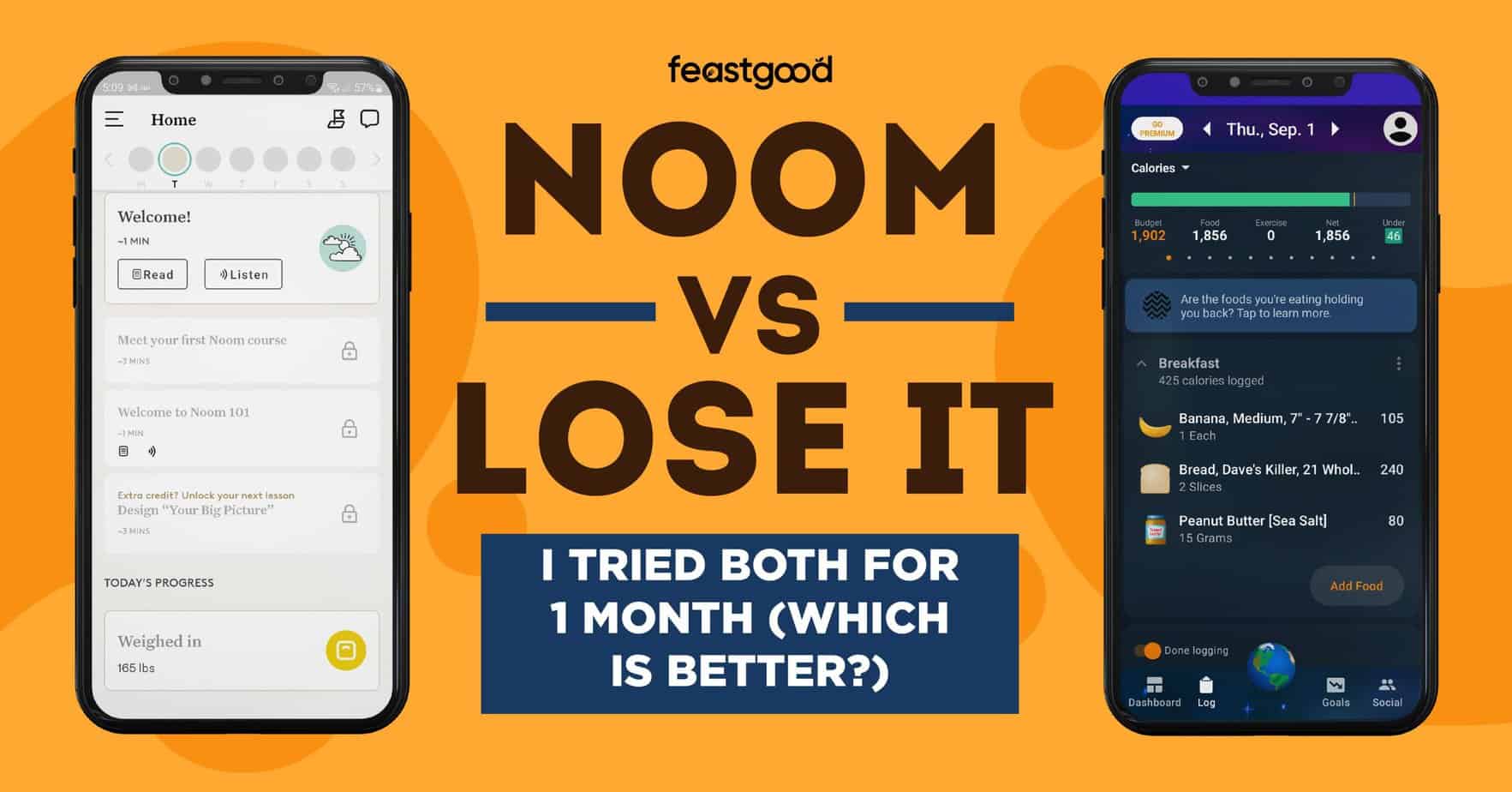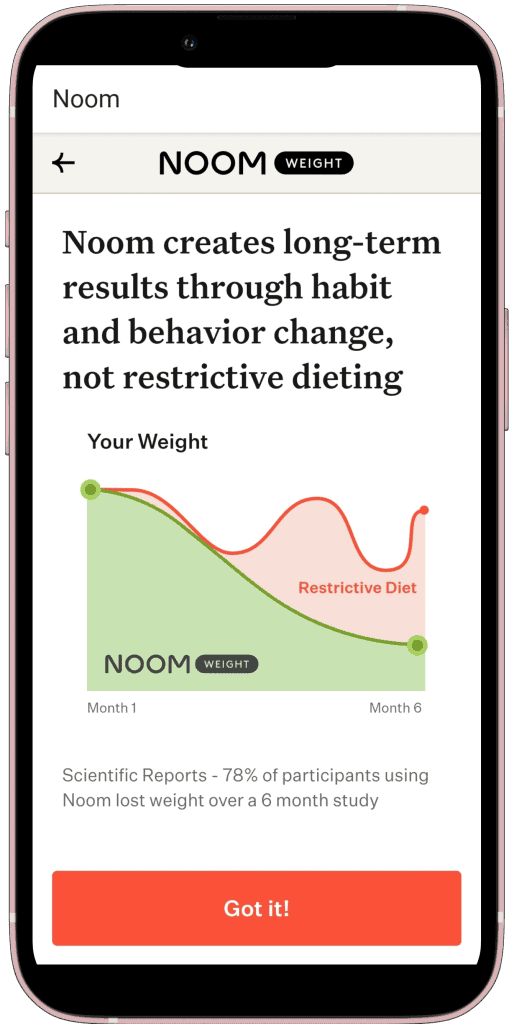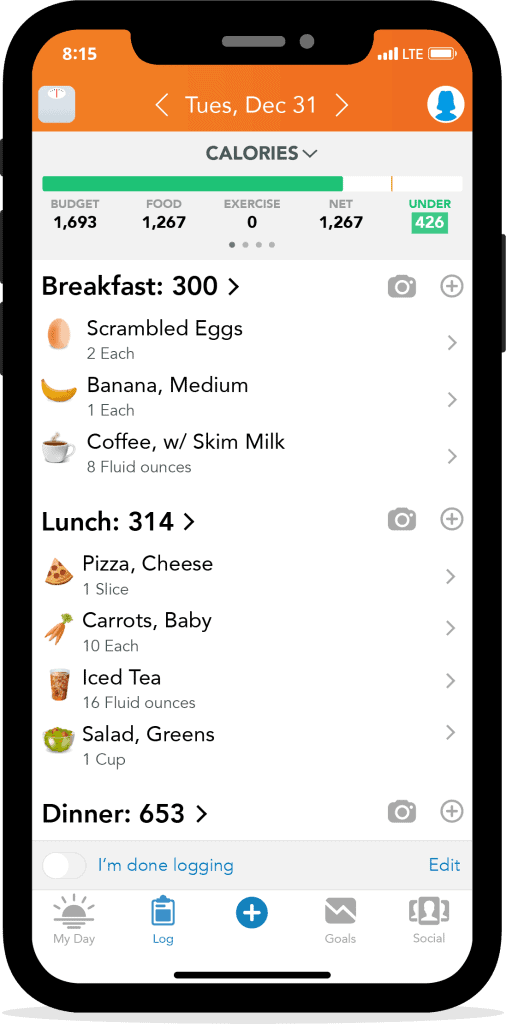Now that I’ve tried both Noom and Lose It for a month, I’ve learned the pros and cons of each and can confidently say which nutrition tracking app is best based on various goals and preferences.
Key Takeaways
- The main difference between Noom and Lose It is that Noom is an educational diet system that teaches you how to change your habits and relationship with food, whereas Lose It is a calorie and macro-tracking app that requires you to take a more self-guided approach to track your intake and reach your goals.
- Lose It was the winner in 6 categories that we reviewed whereas Noom won 3 categories (more on this later). 2 categories were tied. Broadly, it was tough to declare winners, as Noom is more suited for beginners, and Lose It is more suited for advanced users.
- Noom is best for those working toward a weight loss goal and want to learn how to incorporate a variety of foods into their diet (using their “food color” system). Noom also provides psychology-based lessons to improve mindset. Read my complete Noom Review.
- Lose It is best for those who want to track their nutritional intake (calories and macros), and want the ability to customize their own targets as they progress. Lose It requires users to know how to manipulate their calories to meet their goals. Read my complete Lose It Review.
Medical Disclaimer: The content of this article is provided for educational insights only. It should not be used as medical guidance. Individuals with a past of disordered eating should refrain from weight loss programs or calorie tracking. For medical advice, consult a certified healthcare professional. If you’re struggling with eating disorders, contact NEDA for assistance.

What Is Noom?
Noom is a nutrition app that offers daily behavioral psychology and nutrition lessons that help users to change their habits and behaviors for long-lasting results. Noom also provides a calorie range for users to aim for to achieve their goals.
Noom can be used for weight loss, weight maintenance, or weight gain but most people using the app are using it for weight loss.
On top of the daily lessons, users are encouraged to log their intake using Noom’s food database and recipe database to ensure they’re staying within the recommended calorie range.
Noom teaches users that no foods are off-limits with its color categorization (green, yellow, and orange foods) which shows users how often they should aim to consume different foods while pursuing their goals.
The color categorization system is based on their calorie content, with green foods having the lowest calorie content and orange foods having the highest calorie content.
Noom encourages users to consume larger amounts of green and yellow foods than orange foods to help them stick to their calorie range more easily.
However, Noom doesn’t allow users to track their macronutrient intake (carbs, fats, protein), which would be important for users to ensure they’re consuming enough of each nutrient to have energy (carbs), maintain muscle mass (protein), and support hormonal health (fats).
Noom does offer the ability to communicate with a coach via live chat. Noom’s coaches are there to offer encouragement and advice so that users feel supported as they pursue their goals.
The live coaching and behavioral psychology lessons are features that take the app above and beyond, which factors into the price, making Noom the most expensive nutrition app on the market.
Pros
- Daily Behavioral Psychology Lessons
- Calorie Range Offering More Flexibility
- A Large Recipe Database
- Coaching Via Live Chat
Cons
- Calorie Range Is Fairly Large
- Inability To Track Macronutrients (Carbs, Fats, Protein)
- Some Inaccuracies Found In The Food Database (most apps have this problem though)
- Price Is Expensive
Noom App
This link gives you a 14-day free trial for $1. Start by going through Noom’s online questionnaire.
What Is Lose It?
Lose It is a weight loss nutrition tracking app that provides users with a calorie target to adhere to and the option to track macronutrients (carbs, fats, protein) and micronutrients (vitamins & minerals) using its large food database.
The calorie target set by the Lose It App is accurate, which impressed me because many apps on the market underestimate how much users should be eating.
Lose it’s recommendations were realistic and I feel confident that users could achieve their weight loss goals and have a better chance to keep it off.
However, the macronutrient recommendations were not accurate. Luckily, Lose It is highly customizable so you can change any of its recommendations to suit your needs and preferences.
The only issue with customizing your macronutrient intake is that you may not know what an appropriate target is and how to make them equal out to your calorie target.
Therefore, user’s wanting to track their macronutrient intake should set their own targets or hire a coach to help advise them on what targets would be appropriate.
The other downside to Lose It is that it has limited membership options (annual or lifetime) so you will have to commit to a long-term membership if you want to take advantage of the app’s full capabilities.
Pros
- Accurate Calorie Recommendations
- Ability To Customize Recommendations
- Many Progress Tracking Capabilities
- Built-In Community
Cons
- No Recipe Database
- Inaccurate Macronutrient Recommendations
- Lack Of Membership Options
Lose It App
Lose It is best for those who want to focus primarily on calorie counting because its design focuses more on caloric intake than macronutrient intake. It’s an excellent option for those seeking changes in body weight.
Noom vs Lose It: Head To Head Comparison
To compare Noom and Lose It, I’ve put their key features head to head in 11 different categories.
1. Customization
Noom
Noom has little to no customization options, meaning that users are stuck with the calorie range that has been recommended.
Lose It
Lose It is very customizable, providing users with the option to change their calorie, macronutrient, and micronutrient goals.
Not only does the app allow you to customize the number of calories per day but also how these calories are distributed over the week. You can choose whether you want each day of the week to have the same calorie target, or to have high-calorie and low-calorie days.
The only downside to Lose It’s customization is that it comes with very little guidance, so it’s great for those who have the knowledge to make these adjustments but it’s not a great tool for those who don’t know how to set their own targets (i.e. beginners).
The Winner: Lose It
Lose It has many different customizations for users whereas Noom doesn’t allow for customizations.2. Tracking Capabilities
Noom
Noom’s tracking capabilities include calorie intake, exercise activity (steps & exercise), body weight, blood pressure, and blood glucose measures.
Lose It
Lose It’s tracking capabilities include calories, macronutrients (protein, carbs, fats), micronutrients (vitamins & minerals), body fat percentage, measurements (waist, hip, thigh, etc), blood pressure, and blood glucose.
The Winner: Lose It
Lose It has more tracking capabilities than Noom which makes it a better app for tracking progress and perhaps keeping users motivated to continue using the app.3. Recommendation Accuracy
For reference, an appropriate calorie deficit for sustainable fat loss would be a 50-500 calorie deficit (50-500 calories less than it takes you to maintain your weight).
Noom
Noom’s calorie recommendations aren’t as accurate because it uses too large of a calorie range.
For example, it recommended I eat 1330 to 2080 calories per day to lose weight but 1330 calories per day would be almost a 1000-calorie deficit (I maintain my weight at 2300 calories per day) which is completely unsustainable and even unsafe.
However, if I were to eat 1800-2080 calories per day it would be a healthier deficit that would allow me to lose weight and keep it off.
That said, I do LOVE that Noom uses a calorie range because having a range provides the user with more flexibility and makes them feel as though they don’t have to be “perfect” which is better for adherence.
The range on Noom should really be smaller (i.e. 1800-2080 for me). So, f you’re using Noom, just try to stick to the middle of the target on most days.
Lose It
Lose It’s calorie target recommendation was very accurate, which really impressed me because many nutrition tracking apps provide inaccurate calorie recommendations.
Lose It recommended a 400-calorie deficit for me, which is within an appropriate range.
The Winner: Tie
Lose It is more accurate than Noom. However, Noom scores major points in this category because of its use of a calorie range rather than a set calorie target.4. Exercise Calorie Adjustments
Exercise that is logged into an app will be used to estimate how many calories were burned while engaging in the activity. Some nutrition apps take the number of calories you burned through activity and add them back to your daily intake.
These exercise calorie adjustments can work against you when you’re trying to lose weight. Because none of the calories you burn will help you to lose weight.
This makes weight loss harder because you’re relying completely on decreasing your food intake rather than having your food intake and your activity work together to help you lose weight.
Noom
Noom has an exercise calorie adjustment that causes the app to add half of the calories you burn back into your daily intake. This means that some of the calories you burn will help you to lose weight, but not all of them.
For example, if you burned 400 calories throughout the day (from steps and/or exercise), then Noom would add 200 calories back to your intake and you would still have a 200-calorie deficit created from your activity helping you to lose weight.
It would be better if Noom didn’t add any calories back to your intake, but at least they don’t add all of them back (only half). This is a feature that you cannot turn off, which is unfortunate.
Lose It
Lose It adds all the calories you burned from activity back into your daily calorie intake by default; however, you do have the option to turn it off by clicking “exclude from total calories” when you log your activity.
The Winner: Lose It
Although Noom adds fewer calories back into your intake than Lose It, Lose It allows users to turn off the function whereas Noom does not.5. Coaching
Noom
Noom has a coaching feature where users can speak to a coach using a Live Chat Function built into the app. Users can take advantage of the coaching feature by asking for support, encouragement, and help along the way.
When I tested the app, I tested out the coaching feature to verify that the coaches were actually helpful. After chatting with a Noom coach, I was pleasantly surprised by their advice and support.
Lose It
Lose It does not have a coaching feature.
The Winner: Noom
Noom offers coaching that takes the user experience to the next level by allowing users to feel supported.6. Food Database
Food databases generally contain verified and unverified foods.
Verified foods are foods that come from a database that verifies that foods contain accurate nutrition information.
Unverified foods are foods that are not verified to contain accurate nutritional information, are more likely to be incorrect, and are generally user-created.
Noom
Noom is marketed as “the most reliable, comprehensive food database in the world”, with “over 3.7 million options to choose from”; however, it appears as though Noom users aren’t impressed with the accuracy of nutritional information.
This doesn’t surprise me considering they don’t mention whether foods are verified or unverified.
In fact, there is a Reddit thread where Noom users discuss how terrible Noom’s food database really is. Most people within the thread explain that they use Noom for its psychology lessons but track their intake using another app.
Lose It
Lose It’s food database has approximately 34 million foods, including both verified and unverified foods.
However, verified foods are generally verified by a third-party to contain accurate information but it appears as though Lose It’s verified foods are verified by the Lose It team. This makes me nervous that the information isn’t as accurate as it would be if it were verified by an outside party.
The Winner: Lose It
Although I’m not thrilled that Lose It verifies its foods “in-house” rather than using a pre-existing verified food database, there are no complaints from users that the verified foods are inaccurate, whereas Noom users have made it clear that Noom’s food database is very inaccurate.7. Recipe Database
Noom
Noom has an extensive recipe database with over 150 options for breakfast, lunch, dinner, and snacks. Another unique feature about Noom’s recipes is that they tell you what percentage of green, yellow, and orange foods are in the recipe so you can gauge the quality of the ingredients and how it fits into your daily intake.
Lose It
Lose It doesn’t have a recipe database for users to reference for meal inspiration.
The Winner: Noom
Noom has a recipe database to provide users with meal inspiration, but Lose It does not.8. Education
Noom
Noom is known for its behavioral psychology lessons that educate users on their habits and behaviors. Noom also educates users on nutrition so that they understand how much of each particular food can fit into their overall intake.
Not only does Noom provide lessons, but it also quizzes users about information in the lessons to ensure users are retaining the information being presented.
Lose It
Lose It doesn’t provide any education other than the knowledge that comes from tracking your food intake.
The Winner: Noom
The education that Noom provides is incredibly helpful for teaching users about the science behind behavior change and how they can apply it to achieve more long-lasting results.9. Community
Noom
Noom does not have a built-in community within the app.
Lose It
Lose It has a built-in community in the app that allows users to communicate with one another to share their success and offer support and encouragement.
The community aspect of Lose It is great for those who value connection with those who are pursuing similar goals and having similar struggles.
The Winner: Lose It
Lose It provides an opportunity for users to communicate with one another, whereas Noom does not.10. Customer Reviews
Noom
According to Google Play, Noom has 4.3 / 5 stars from 287,000 reviews.
Noom’s rating falls short because users are unimpressed by the food database and its inaccuracies.
However, users were incredibly impressed with Noom’s attention to detail in their psychology lessons. Even those who gave the app a negative review commented on how beneficial the lessons are.
Lose It
According to Google Play, Lose It has 4.5/5 stars from 126,533 reviews.
Lose It has many positive reviews because customers really did lose weight by using the app, which is what they set out to do when downloading the app.
The negative reviews were mainly related to the app glitching for certain users; however, I never experienced any glitching during my month of using the app.
The Winner: Tie
Lose It has fewer negative complaints and a higher rating than Noom; however, it is important to acknowledge that Noom has far more reviews than Lose It so it’s not entirely a fair comparison.11. Price
Noom
Noom has a variety of membership options but regardless of which option you choose, Noom is the most expensive nutrition app on the market.
Some believe that Noom is priced fairly based on its psychology lessons which can make the difference between actually changing your behaviors and achieving the results you’re looking for or not.
However, others feel the price is unfair because of its inaccurate food database and lack of basic logging functions (macro tracking, bodyweight measurements) that some free apps offer.
Lose It
Lose It only has 2 membership options (one year & lifetime) which is incredibly strange because generally, apps will have a 1-month option so that users can try the app before committing to a longer term.
If users don’t enjoy the Lose It app after a couple of months, then they’re out of luck because they’ve already paid for the entire year.
That said, it is really nice that you can pay a one-time fee and use the app forever because if you really enjoy the app and plan on using it long-term, you can save a ton of money compared to other apps that only offer month-to-month and annual memberships.
The Winner: Lose It
Although Lose It only gives you 12-month or lifetime options, 12 months of Lose It is still cheaper than a 2-month membership to Noom. Lose It also has far more tracking capabilities than Noom, but the lower price will cost you a recipe database and education opportunities.- Related Article: Apps Like Noom But Cheaper
Noom vs Lose It: Quick Overview
| Noom | Lose It! | Our Interpretation | |
|---|---|---|---|
| Food Categorization Based On Quality | Colors (Green, Yellow, and Orange Foods) | None | Noom educates users about food quality; Lose It doesn’t provide this learning opportunity. |
| Tracking Capabilities |
|
| Lose It Is more data-oriented allowing users to track a variety of measures of progress. |
| Calorie Recommendations & Accuracy | Calorie Range - Somewhat Accurate | Specific Calorie Target - Accurate | Noom provides more flexibility with its calorie range but isn’t as accurate as Lose It’s calorie recommendation. |
| Level Of Customization | No Customizations Available | Ability To Customize Calorie, Macronutrient, and Micronutrient Goals | Lose It gives the user opportunities to customize the app to suit their needs and preferences. |
| Education Opportunities | Daily Psychology and Nutrition Lessons | No Education Opportunities | Noom focuses on education to set users up for long-term success; Lose It does not. |
| Coaching | 1:1 Coaching Included In Membership | No Coaching Option | Noom allows users to work with a coach for additional support and troubleshooting. |
| Recipe Database & Meal Planning | Large Recipe Database | No Recipe Database Or Meal Plans | Noom provides users with meal inspiration, which is a big value add. |
| Exercise Calories | Half Of The Calories Burned Are Added Back To Your Intake | All Of The Calories Burned Are Added Back To Your Intake | Both apps add the calories you burn back into your daily intake, but Noom adds fewer calories than Lose It. |
| Price |
|
| Noom is much more expensive than Lose It (and most other nutrition apps on the market). |
| Reviews | 4.3/5 stars | 4.5/5 stars | Lose It has a higher rating than Noom; however, Noom has 160,467 more reviews than Lose It. |
Other App Comparisons
About The Author

Amanda Parker is an author, nutrition coach, and Certified Naturopath. She works with bodybuilders, Olympic weightlifters, and powerlifters to increase performance through nutrition and lifestyle coaching.
Why Trust Our Content

On Staff at FeastGood.com, we have Registered Dietitians, coaches with PhDs in Human Nutrition, and internationally ranked athletes who contribute to our editorial process. This includes research, writing, editing, fact-checking, and product testing/reviews. At a bare minimum, all authors must be certified nutrition coaches by either the National Academy of Sports Medicine, International Sport Sciences Association, or Precision Nutrition. Learn more about our team here.
Have a Question?
If you have any questions or feedback about what you’ve read, you can reach out to us at [email protected]. We respond to every email within 1 business day.



